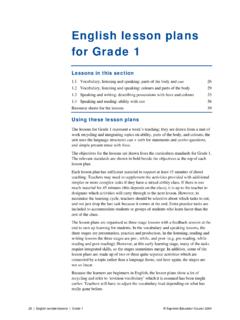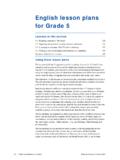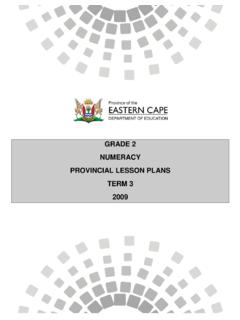Transcription of English lesson plans for Grade 11 - sec.gov.qa
1 337 | English sample lessons | Grade 11 Supreme Education Council 2004 English lesson plans for Grade 11 Lessons in this section 11 Foundation 1 Speaking: the chocolate factory 338 11 Foundation 2 Listening: The price of greatness 341 11 Advanced 1 Integrated skills: preparing a presentation 347 11 Advanced 2 Reading and summarising a text: Hair 350 Resource sheets for the lessons 354 Using these lesson plans The lessons for Grade 11 represent the range of skills but are not specifically linked. The focus is moving away from discrete-item grammar towards skills and tasks. There is also a move to integrate one or more skills in the completion of the task and to involve the students in researching topics from the Internet.
2 The objectives for the lessons are drawn from the curriculum standards. Main standards are listed in bold and subsidiary standards in normal print under the objectives at the top of the lesson plan . Each lesson plan has sufficient material to support at least 45 minutes of direct teaching but many of the activities stretch into a homework or the next lesson , for example lesson lesson 11 Foundation 1 involves a task-based simulation, where students adopt roles in order to complete a specific task. The outcome of the task is not fixed at the beginning, this demands a more involved level of oral interaction to complete the task. lesson 11 Foundation 2 requires students to evaluate and respond to a persuasive argument in a listening text, as well as use the Internet to search for information about famous people.
3 lesson 11 Advanced 1 involves the students preparing a ten-minute oral presentation on an issue-laden topic. They are given a structure, but are required to search the Internet for content details. Grade 11 Advanced 2 integrates reading with summary writing and gives students a series of steps to follow in order to reduce a text to about half its original length. Answer keys are provided to guide teacher correction and feedback but where tasks are subjective, these answers are not intended to be presented to students as the only right way of completing the given tasks. 338 | English sample lessons | Grade 11 Supreme Education Council 2004 Speaking: the chocolate factory Interact in group, paired and more formal discussion, speaking at length.
4 Show awareness of other participants. Discuss a present scenario, weighing alternatives, options and consequences. Some of the procedure and materials for this lesson are adapted from Business Roles by John Crowther Alwyn, Cambridge University Press 1997. Set the scene Show OHT Ask the students about their chocolate-eating habits. What s your favourite chocolate bar? Do you like nuts in the chocolate? Which is your favourite brand of chocolate? Cadbury s, Mars, Hershey? What other brands do you know? Why do you think chocolate is so popular? If you are a lover of chocolate, what do you think the ideal job would be? Owner of a chocolate factory? Chocolate taster? Do you know what chocolate is made from?
5 Show OHT Get students to refer to this website for more information about chocolate: Ranking Tell the students that they work for a chocolate manufacturer in Australia. The company is intending to build a new factory. Hand out worksheet Get students to look at the list of important factors to be considered when deciding where to put the factory. In pairs, have them choose the 10 most important factors. When this has been done, show OHT to get feedback from all the pairs. Go through the list of factors, and find out how many pairs have chosen that particular factor. The 10 factors with the most votes will form the list for the class. Guide the class in their choices to help them focus on the key factors. Get them to eliminate factors of little importance.
6 Beauty of site, near to a beach. Have students sort factors into those which are important to the workers and those which are important to the management. Students discuss the problems that arise from these different needs. quality of public transport, cost of housing in the area, quality of facilities availability of government subsidies, loans etc.; labour costs; location of competitors Objectives Grade 11F curriculum standards , , , , , Presentation Resources OHTs , , Worksheet 339 | English sample lessons | Grade 11 Supreme Education Council 2004 Get them to separate the direct-interest factors from social and environmental factors that may not affect the workers or the managers but may affect the community as a whole. image of town, area or country, levels of pollution, social problems in area Get students to rank their key factors from 1 to 10.
7 Monitor to find pairs with different rankings, put the pairs together and get them to justify to each other their selection and order. The important thing here is to introduce the students to the factors which they will be discussing later, and to get them to think about the issues from a disinterested point of view so that they can then compare their changing point of view once they become commercially involved. Preparation Hand out worksheet Give students time to read it and then check comprehension with a few questions. Explain any difficult vocabulary. Hand out worksheets (i) and (ii) and tell students these are their fact sheets. Briefly explain that: the first graph shows the cost of factory space; the second graph shows the cost of labour in the places under consideration; the map shows the main population centres.
8 Hand out role cards prepared from teacher s resource If there is an odd number, get two students to job share or leave out some of the jobs, for example F or G. The more demanding roles are A and C; decide whether to give these to more fluent students or the less prominent students. Get students to read through their roles. Ask them to find all the other students with the same role and to sit together. They may end up in pairs, threes or fours, depending on the size of the class. Get them to prepare their common role together. Give them some time to think, discuss and note down what they wish to say. Monitor, answer any questions they may have and ask checking questions to make sure they have understood the implications of their role. Questions to the Chief Executives: Why do you favour Melbourne?
9 Why can t you say so at the beginning of the discussion? Question to the Production Managers: Why do you think Perth is the best location? Question to the Financial Directors: Why not Geelong? Question to the Head of Sales: Why Sydney? Have students practise speaking with each other, taking it in turns to argue their point of view, refine it, add better ideas from the group. Make sure they are not reading from their role cards and emphasise eye contact, body language, repetition of key ideas, etc. Roleplay When they are ready, put students into groups of seven so that each role is represented in each group. Show OHT and encourage students to use these phrases in their discussion. Practice Resources Worksheets , (i) and(ii) Teacher s resource Production Resources OHT Worksheet 340 | English sample lessons | Grade 11 Supreme Education Council 2004 Tell students they are having a board meeting and the aim of the meeting is to arrive at a decision as to which site would be the best for the new chocolate factory.
10 Tell students to follow the agenda below during their board meeting. 1 Board members introduce themselves and say what their job is. 2 Chairperson starts the discussion by outlining the advantages and disadvantages of each site. 3 Board members each express their point of view. Others can interrupt, agree or disagree, ask for clarification etc. by using the phrases on OHT 4 When everyone has had their say, the Chairperson concludes the discussion by getting the group to reach a decision, based on the discussion. Leave the chairpersons to chair their meetings. There is no one correct answer to the discussion. Allow different groups to come up with different solutions. Don t interrupt and try not to correct language errors during discussion.












